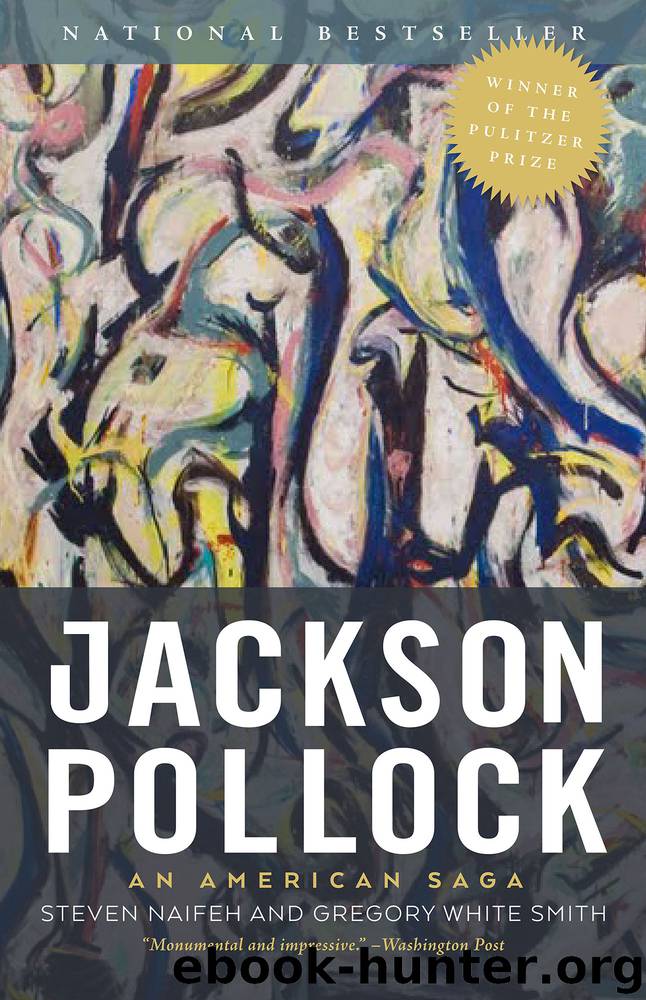Jackson Pollock by Steven Naifeh & Gregory White Smith

Author:Steven Naifeh & Gregory White Smith
Language: eng
Format: epub
Tags: Fiction
Publisher: Jackson Pollock
Published: 2013-02-25T16:00:00+00:00
35
CELEBRITY
By 1948, the art world was ready for a star.
The market was ready. The postwar tidal wave of consumer spending that put two cars in every garage and meat at every meal had finally reached Fifty-seventh Street. Between 1940 and 1946, the number of private galleries in Manhattan nearly quadrupled. After 1944, sales at many galleries doubled and tripled every year. Art was no longer an indulgence for the rich only—the Mellons, Fricks, Baches, and Wideners—it was a consumer good, as available to the middle class as canned beer, nylon stockings, and golf balls. "For the first time in history," writes Marxist historian Serge Guilbaut, "art became a part of everyday life, a part of the environment, a decoration in middle-class homes." In 1942, when Gimbel's department store offered for sale items from William Randolph Hearst's collection of old master paintings, Gimbel's rival, Macy's, countered with its own "sale," announced in the New York Times: "authenticated paintings by Rembrandt, Rubens, etc. ... A $130,000 collection of paintings at our lowest prices. ... Pay only one third down on Macy's cash time, take months to pay, plus the service charge." When Macy's sold Rembrandt's Portrait of an Old Man for $6,894, Gimbel's countered with his Portrait of a Child at the "amazingly low price" of only $9,999.
America was ready. In 1946, with Europe still half buried in the rubble of war, Walter Lippmann announced the dawn of "the American century." "Fate has willed it," he proclaimed in a Paris magazine, "that America is from now on to be at the center of Western civilization rather than on the periphery." The year before, View magazine had bragged that "New York is now the artistic and intellectual center of the world," to which the critic Germain Bazin replied with prescient derision: "Will the Paris School become the New York School?" Some Europeans saw the future more clearly. "American painting ... is developing rapidly," warned critic Léon Degand in 1946. "Young painters are throwing themselves into their work with such intensity that it is impossible that [America] ... will not one day achieve an original style of its own. ... I am convinced that the Americans are on the way toward a period of greatness in art."
The media were ready. The vast armies of new consumer-collectors needed advice on what to buy. They knew they wanted art; they wanted American art (wartime patriotism was still in vogue); and some even wanted avant-garde art (because that's what the Rockefellers and Blisses wanted). But within those broad parameters, many of the new collectors lacked the confidence to make their own distinctions. Only a handful could attend the gallery shows, like Bertha Schaefer's "The Modern Home Comes Alive" and Samuel Kootz's "Modern Painting for a Country Estate: Important Paintings for Spacious Living," which were mounted to help educate (and sell) them on the new art. Instead, most turned for advice on how to buy art to where they turned for advice on how to buy everything else: the media—especially the magazines.
Download
This site does not store any files on its server. We only index and link to content provided by other sites. Please contact the content providers to delete copyright contents if any and email us, we'll remove relevant links or contents immediately.
Housekeeping by Marilynne Robinson(4347)
Papillon (English) by Henri Charrière(4197)
The Poetry of Pablo Neruda by Pablo Neruda(4040)
World without end by Ken Follett(3429)
TCP IP by Todd Lammle(3134)
Fluent Forever: How to Learn Any Language Fast and Never Forget It by Gabriel Wyner(3030)
The Rape Of Nanking by Iris Chang(2774)
How Proust Can Change Your Life by Alain De Botton(2742)
The Alchemist by Paulo Coelho(2645)
The Partner by John Grisham(2349)
Two lives by Helen Naylor(2270)
Hitler by Ian Kershaw(2155)
Yerma by Federico García Lorca(2016)
Sophie's World by Jostein Gaarder(1970)
Smilla's Sense of Snow by Peter Hoeg(1907)
Merriam-Webster's Pocket Dictionary by Merriam-Webster(1882)
Twilight of Idols and Anti-Christ by Friedrich Nietzsche(1850)
Il cavaliere inesistente by Italo Calvino(1827)
Deep Writing by Eric Maisel(1784)
